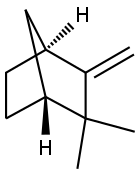Camphene is a colorless to white crystalline
solid, Camphor, or turpentine odor. It may be shipped as a
liquid. Freezing/Melting point 5 50�C.
ChEBI: Camphene is a monoterpene with a bicyclic skeleton that is bicyclo[2.2.1]heptane substituted by geminal methyl groups at position 2 and a methylidene group at position 3. It is a widespread natural product found in many essential oils. It has a role as a plant metabolite and a fragrance. It is a monoterpene and a carbobicyclic compound.
Camphene is used to manufacture synthetic camphor; for making moth-proofing and in the cosmetics, perfume, and food flavoring industries.
UN1325 Flammable solids, organic, n.o.s.,
Hazard Class: 4.1; Labels: 4.1-Flammable solid. UN2319
Terpene hydrocarbons, n.o.s., Hazard Class: 3; Labels: 3-
Flammable liquid
Crystallise it twice from EtOH, then repeatedly melted and frozen at 30mm pressure. [Williams & Smyth J Am Chem Soc 84 1808 1962.] Alternatively it is dissolved in Et2O, dried over CaCl2 and Na, filtered, evaporated and the residue is sublimed in a vacuum [NMR: Hana & Koch Chem Ber 111 2527 1978].
Forms explosive mixture with air.
Emulsions in xylene may violently decompose on contact
with iron or aluminum above 70�C. Incompatible with oxidizers (chlorates, nitrates, peroxides, permanganates, perchlorates, chlorine, bromine, fluorine, etc.); contact may
cause fires or explosions. Keep away from alkaline materials, strong bases, strong acids, oxoacids, epoxides. Contact
with reducing agents may cause exothermic reaction,
releasing flammable hydrogen gas
Dissolve or mix the material
with a combustible solvent and burn in a chemical incinerator equipped with an afterburner and scrubber. All federal,
state, and local environmental regulations must be
observed.
